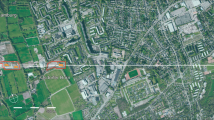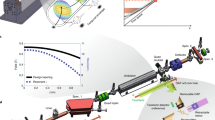Abstract
We analyze the general class of constant period free-electron lasers (FELs) based on single-pass linear accelerator technology. The emittance and energy spread of the electron beam used to drive an FEL must be chosen to match the acceptance of the FEL wiggler. This acceptance determines the attainable current, and the current determines the gain and power output. For an optimized system in which the optical mode size in the interaction region is minimized, the gain is found to be independent of the laser length, while the efficiency and power output scale as the inverse and inverse cube of the length. Very high power output and good efficiencies are predicted.
Similar content being viewed by others
References
G. Dattoli, A. Marino, A. Renieri: IEEE Trans. NS28, 3194 (1981) L. R. Elias, W. M. Fairbank, J. M. J. Madey, H. A. Schwettman, T. I. Smith: “A Discussion of the Potential of the Free Electron Laser as a High Power Tunable Source of Infrared, Visible and Ultraviolet Radiation,” Proc. Synchrotron Radiation Facilities, Quebec Summer Workshop, Université Laval, Quebec, Canada (June 1976)
N. M. Kroll, P. L. Morton, M. N. Rosenbluth: “Enhanced Energy Extraction in Free-Electron Lasers by Means of Adiabatic Decrease of Resonant Energy” inFree-Electron Generators of Coherent Radiation ed. by S. F. Jacobs et al. (Addison-Wesley, Reading, MA: 1980) p. 113
D. A. Reilly, M. S. Tekula, R. M. Patrick: “Beam Heating Constraints on a Low-Voltage Free-Electron Laser with Visible Output” inFree-Electron Generators of Coberent Radiation ed. by S. F. Jacobs et al. (Addison-Wesley, Reading, MA: 1980) p. 681
A. Renieri: “Feasibility and performance of the free electron laser,” Frascati Report 79/30; and “The free electron laser:e-beam and special insertion parameters,” Frascati Report 77/30 P. Sprangle, Cha-Mei Tang: Bull. Am. Phys. Soc.25, 948 (1980)
V. K. Neil: “Emittance and Transport of Electron Beams in a Free Electron Laser,” SRI Report JSR-79-10 (December 1979)
J. M. J. Madey, H. A. Schwettman: Final Technical Report to ERDA for Contracts EY 76-S-03-0326, PA48 and PA49 (October 1977)
J. P. Blewett, R. Chasman: J. Appl. Phys.48, 2692 (1977)
W. B. Colson: Phys. Lett.64A, 190 (1977)
A comparable peak current was achieved in the NINA linac injector, although the current density obtained from the linac fell somewhat below the value predicted by the Lawson-Penner relation
Author information
Authors and Affiliations
Additional information
Work supported by the Office of Naval Research




